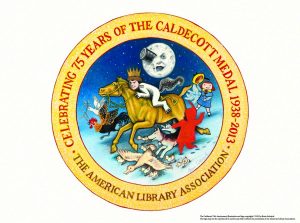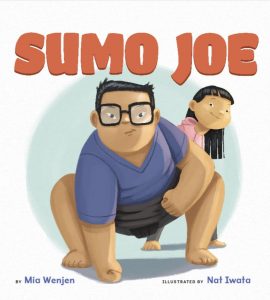I’m no expert in predicting the Caldecott but it’s a fun exercise. While it’s an award for illustration, I think it’s more than that.
The Caldecott Medal was named in honor of nineteenth-century English illustrator Randolph Caldecott. It is awarded annually by the Association for Library Service to Children, a division of the American Library Association, to the artist of the most distinguished American picture book for children.
dis·tin·guished
successful, authoritative, and commanding great respect.
Caldecott Picture Books Should Appeal to a Wide Audience
The Caldecott is determined by adults, first and foremost, so the picture book has to appeal to adult sensibilities who then imagine this book for a young audience. I think this broad audience is also a fundamental characteristic for winning a Caldecott. In fact, the broader the better, both in age and in subject matter.

Caldecott Books Should Have a Timeless Appeal
I think the picture book to win a Caldecott should also be able to transcend the vagaries of time in terms of staying relevant far into the future. There’s nothing sadder than an old Caldecott picture book that no one reads anymore, like an anachronistic relic from the past, dug up in a dusty attic to be ridiculed that someone actually read this book and liked it a long, long time ago. That’s where the story comes into play.
Caldecott Books Seamlessly Combine Story with Illustrations
I think it’s easier said than done. The graphic design of the pages which is often in the hands of neither the author or illustrator can make or break a picture book. Take Teacup by
Caldecott Books Should Be a Discovery?
This is the outlier point for me. I think a great Caldecott winner is a discovery for a well read audience. It’s easy to give the award over and over again to the likes of say … David Weisner, Jon Klassen, Marla Frazee and others, but isn’t even more exciting to put a new illustrator front and center like Ekua Holmes?
Caldecott stickers mean big time sales … and doing the same old, same old is a disservice to the role that picture books can play in social justice. In a world where children’s book publishing has historically been a largely white female industry, white privilege is its silent partner in crime. And while, compared to Hollywood, children’s book publishing has its heart in the right place, there’s still the bottom line to consider.
Can a children’s book change a young reader’s life? Can it open doors? Can it be a shining beacon against racism, bias, bullying and unkindness? I think so. Isn’t why we all love children’s books?
p.s. My Caldecott/Newbery predictions are here: 2016, 2015, 2014, and 2013.
Our Top Pick for 2017 Caldecott
Du Iz Tak? by Carson Ellis
It’s hard to come up with a unique concept for a picture book I think. Don’t most picture books remind you of another? Du Iz Tak? scores high points for me by being a kind of wordless picture book with a made up language that also combines an butterfly and plant life cycle with a fantasy insect world. This is also a great picture book to teach context clues. [picture book, ages 2 and up]
Serious 2017 Caldecott Contenders
The Uncorker of Ocean Bottles by
This has all the element of a Caldecott winner, the only questionable is that Erin E. Stead has won Caldecott accolades in the past, but truth be told, this picture book deserves to win. The story reminds me of Somebody Loves You, Mr. Hatch, but it’s even more poetically told than that. Stead’s illustrations are haunting and warm, at the same time, like a foggy day at your favorite beach. [picture book, ages 4 and up]
The Night Gardener by The Fan Brothers, Terry and Eric Fan
This book reminds me of Grandpa Green by Lane Smith which also won Caldecott honors but I like the illustrations even a tad more. What’s nice is the way the illustrators use color to convey mood; the pages with topiaries burst with color, but those without are more monotone, giving the book a dream-like quality. The illustrations of people are also well rendered, both accurately and in an appealing way. There’s a magical quality to this book that mimics the magic of turning a bush or a tree into a topiary. For those who think a debut illustrator/author can’t possibly win a Caldecott, I’d like to see this win to disprove this! [picture book, ages 4 and up]
They All Saw a Cat by Brendan Wenzel
I’m a huge fan of the trend of nonfiction mirroring fiction. No more boring side bars or blocky chunks of factoids! There’s a science lesson subtlety folded in the story of how different animals see, but it’s subordinate to the cat’s adventures as it wanders through the world. This book reminds of The Very Hungry Caterpillar by Eric Carle where science meets whimsy (and how is it even possible that it didn’t win a Caldecott?!!) [picture book, ages 2 and up]
Radiant Child: The Story of Young Artist Jean-Michel Basquiat by
Javaka Steptoe is remarkably connected to Jean-Michel Basquiat and he channels the artist in the illustrations that he creates for this biography picture book. Steptoe’s artwork mimics the energy and rhythm of Basquiat’s work while including his major works in a way that makes this book a layered treasure to unfold and discover. Basquiat’s short life is also lovingly presented like the blazing comet that he was. What I especially love about this book is how it can be read on different levels; the story will appeal to everyone, including young children, but older kids and even adults can use this picture book to step deeper into art history to be seduced into learning more about Basquiet’s art and life. [picture book, ages 4 and up]
The Storyteller by Evan Turk
This lovely picture book reads like a folk tale but it’s a new story about Morocco and the power of storytellers. Long ago in Morocco, the kingdom has fountains of cool water and storytellers to bring people together, but as the kingdom grew, things changed. Soon there was only a single storyteller left and a thirsty kingdom in danger of being snuffed out by the desert. A young boy hears the stories from this last storyteller and is able to use the power of a well told tale to overpower the desert. This is a story within a story, which is especially fun to read. The timelessness of this story combined with the lush, unique illustrations put it on Caldecott watch! [picture book, ages 4 and up]
Thunder Boy Jr.by Sherman Alexie, illustrated by Yuyi Morales
My arty daughter likes the trend of hand lettered text becoming part of the art. In the same way that Last Stop on Market Street by
I never learned about Congo Square in AP U.S. history class, and it is significant for a number of reasons. It was a unique meeting place in New Orleans where slaves had a taste of freedom one afternoon a week. This feels to me like a very important story to tell.
In lyrical rhymes that appeal to very young readers, Carole Boston Weatherfold conveys the slave experience in an authentic way, neither making slavery seem happy with smiling slaves, or ignoring the harsh punishments slave owners used.
The vibrant primitive art illustrations are well matched to convey the story as well. Color is used in a metaphorical way; the bright yellow of the sky depicts freedom for the slaves. With six more days to Congo Square, the sky is but a 1/6 sliver compared to the expanse of the dirt brown field. As the slaves let loose on their day off, the pages explode with yellow cut with orange hues. A deliberate use of color? I think so.
The uniqueness of Congo Square — a place for slaves and free blacks to meet just one afternoon a week — is an important story to be told to a broad audience. Congo Square now has a deep place in history as the birthplace of jazz, but its roots in slavery conveys American history in a more nuanced and complete way making this a picture book that I am rooting for to win many awards including a Caldecott. [picture book, ages 2 and up]
Miracle Man: The Story of Jesus by John Hendrix
Because my children do not attend church, I like to have them learn about world religions through books and I think the Bible is especially important because it’s part of our culture. What is great about Miracle Man is that the story of Jesus reads like a story, and less like a religious message, and by doing that, this well known story (or really sets of stories) has a freshness. The voice of the, at times, doubting disciples, is especially a strong point of the book, helping to bring the reader back to this time when no one was quite sure what to make of Jesus. The illustrations also depict a real person rather than a religious image of perfection, while at the same time capturing the miracles. I especially liked the reference to Hiroshige’s The Great Wave in the illustration of a terrifying storm that Jesus and his disciples sailed through, and Jesus ended the storm in an instant. [picture book, ages 4 and up]
Jazz Day: The Making of a Famous Photograph by
It was quite a feat to pull off the Esquire American Jazz photo, just like it is a feat to pull off this free verse poetry picture book that so perfectly captures the excitement, chaos, and personalities of that momentous day. It is also a feat to get kids to read poetry, so I’m rooting for Jazz Day to wrack up some awards. [poetry picture book, ages 8 and up]
A Great Day in Harlem, Wikipedia
Ideas Are All Around by Philip C. Stead
I really like all the picture books about how to write a story. Philip C. Stead takes this concept to personal level as he shows readers how he can find a story even when he is stuck. The blend of photographs that convey his real life, with his block print, mixed media illustrations is a uniqu and appealing mix. I think this has a shot of winning but isn’t quite as strong as the other picture books above. Still, I like the unique and personal point of view. It’s like an author visit in a book. [picture book, ages 4 and up]
We Love This Picture Book But…
Teacup by
The illustrations are gorgeous and I love the allegorical story of a refugee experience. Where the picture book stops working for my daughter is the layout. She objects to the text treatment and placement and it ruins the book for her. [picture book, ages 4 and up]
The Journey by Francesca Sanna
I think this is such an important picture book for kids and adults alike. Sanna’s picture book conveys a refugee’s experience and doesn’t skimp on the dark parts — escaping a war-torn country, the death of a parent, avoiding capture, paying someone for help to cross the border, and a difficult sea journey. There is still more including refugee camp, and facing racism in the new country that takes you in that the story stops short of. Still, there is enough here to teach kids compassion for the refugee experience. This is a book that I would like in every classroom library. [picture book, ages 5 and up]
Are You An Echo?: The Lost Poetry of Misuzu Kaneko by David Jacobson, Sally Ito and Michiko Tsuboi who wrote the narrative and did the translation, illustrated by Toshikado Hajiri
All Japanese children read her deeply compassionate poems about creatures in the natural world. Think of her as a Japanese Pablo Neruda and/or Emily Dickerson. Her sad, short life is depicted in this biography/poetry hybrid picture book. This combo really works for me since she is unfamiliar to most of us. Her poems are deceptively simple and kids can really relate to them. I hope this wins a Caldecott but I hesitate to add it to my watch list because the rendering of the faces in the illustrations were too cartoon-y and didn’t go with the rest of the illustration style. [biography and poetry picture book hybrid, ages 4 and up]
p.s for an Emily Dickinson poetry book, try Poetry for Kids Emily Dickinson, edited by Susan Snively, illustrated by Christine Davieier. It pairs nicely with Are You An Echo?
A Child of Books by Oliver Jeffries and Sam Winston
This is the kind of outlier that could win though I feel like it appeals more to adults than children. As a prose poem to beloved classics, it’s a nostalgic love song to how important children’s books are in creating a wonderful escape for kids. The use of actual words from these books, done in a illustrative way, is what brings this book into Caldecott territory. This is a quiet story for any age lover of children’s books. [picture book, ages 4 and up]
Seriously Funny Picture Books That Won’t Win But Are Great!
We Found a Hat by Jon Klassen
The color palette is so unique in this funny picture book. Doesn’t it seem like most picture books use primary colors? With sandy hues of umber and sienna, this simple color scheme matches well with the dry humor and minimalist illustrations. It seems like, as part of a trilogy, it should win a Caldecott, if only for the sake of symmetry. Still, I think the competition is too steep and the bar is raised ever higher for a previous winner. Don’t me wrong; this is a delightful picture book. It will win awards but probably not a Caldecott. [picture book, ages 2 and up]
Penguin Problems by Jory John, illustrated by Lane Smith
This is such a hilarious book that all kids of any age can relate to. A young penguin conveys with dry sarcasm the problems it faces every day. I especially like the zen perspective conveyed in the end to the young penguin by a wise walrus. There should be a special children’s book award for humor, and if there was one, this book would cinch it. [picture book, ages 4 and up]
Mother Bruce by Ryan T. Higgins
A curmudgeon male bear with a flock of goslings? The set up for humor is perfect and well executed. This pitch perfect funny picture book reminds me of Hog-Eye. [picture book, ages 4 and up]
Bob the Artist by Marion Duchars
My daughter loves how the hand-lettered typography are part of the artwork. In fact, it’s her favorite part. There is a graphic design minimalist quality to the illustrations that we both like a lot too. There are three themes in this book that we like as well: anti-bullying, find your inner artist, and self acceptance. The fact that this picture book can convey so much AND be funny makes it a winner in my book! [picture book, ages 4 and up]
To examine any book more closely at Amazon, please click on image of book.
As an Amazon Associate, I earn from qualifying purchases.
Follow PragmaticMom’s board Multicultural Books for Kids on Pinterest.
Follow PragmaticMom’s board Children’s Book Activities on Pinterest.
My books:
Amazon / Signed or Inscribed by Me
 Amazon / Signed or Inscribed by Me
Amazon / Signed or Inscribed by Me
Food for the Future: Sustainable Farms Around the World
- Junior Library Guild Gold selection
- Selected as one of 100 Outstanding Picture Books of 2023 by dPICTUS and featured at the Bologna Children’s Book Fair
- Starred review from School Library Journal
- Chicago Library’s Best of the Best
- 2023 INDIES Book of the Year Awards Finalist
- Green Earth Book Award longlist
- Imagination Soup’s 35 Best Nonfiction Books of 2023 for Kids
Amazon / Barefoot Books / Signed or Inscribed by Me



































Great picks. It is fun choosing. I’d add “Before Morning” with its beautiful sketch art illustrations by Beth Krommes.
I have to read Before Morning! I missed that one!!!
It makes me so happy to consistently see nonfiction titles in these Caldecott lists! It does feel like a golden age for nonfiction picture books, and I’m glad librarians, teachers, and parents are embracing them!
I do love the trend in nonfiction picture books to be fiction-like and very creative in terms of hybrid themes too! Love how children’s books are always evolving and improving.